De Bethune Dream Watch 5 Maestri’Art Cempasúchil: Celebrating Mexico, Art, And The Dearly Departed
It’s right there in the name: DREAM WATCH.
And when the first De Bethune Dream Watch 5 appeared in January 2014, that’s exactly what it made me do: dream. I obsessed over it, I dreamt about it.
Dream Watch 5 was so unique, so different, so perfect that I fell instantly in love. Little did I know, though, that De Bethune would continue to release various highly limited editions of the Dream Watch 5 to keep me dreaming, drooling, and wanting. And the latest – Dream Watch 5 Maestri’Art Cempasúchil – is no exception.
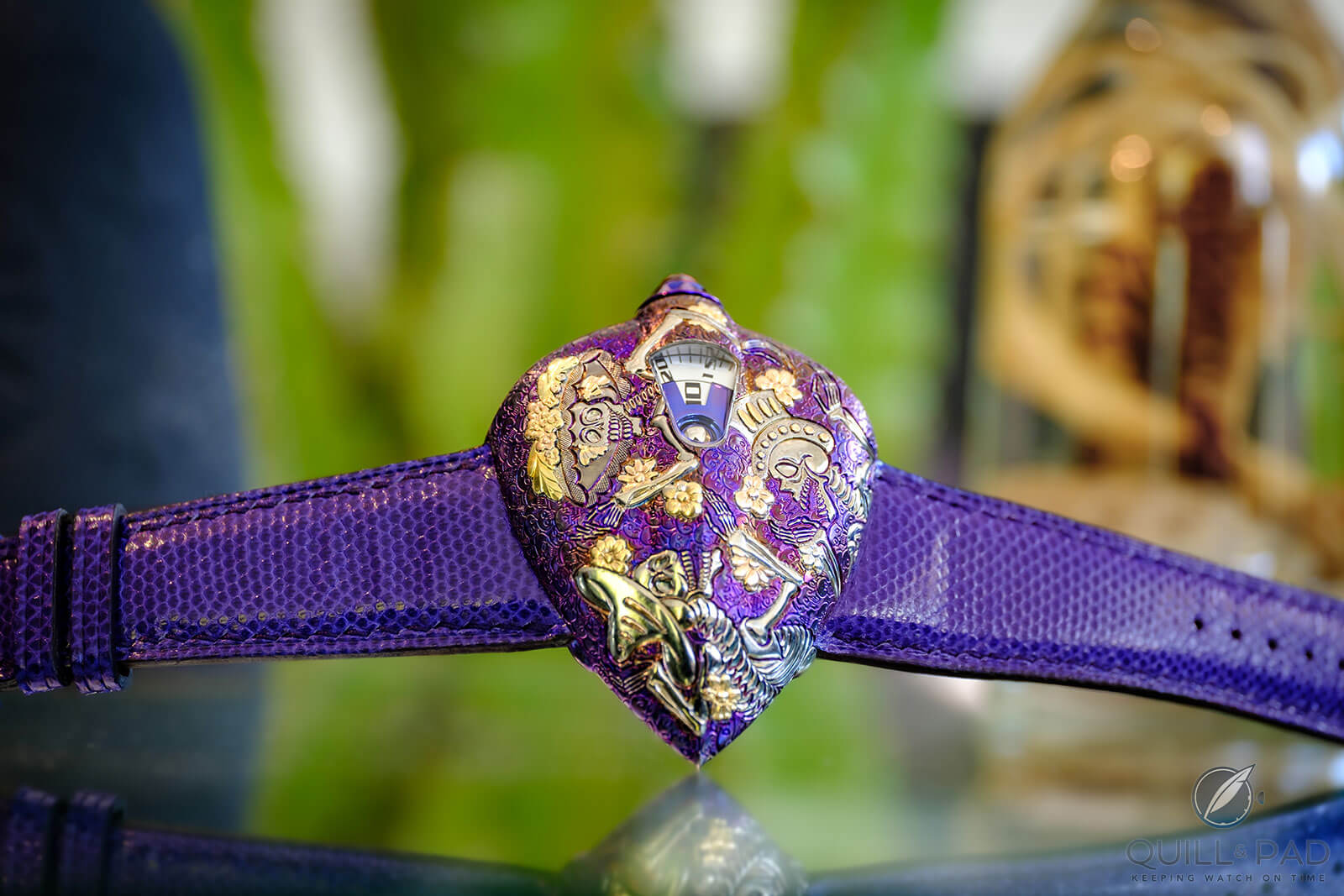
De Bethune Dream Watch 5 Maestri’Art Cempasúchil
It’s as if it were some sort of ray of wonder and hope coming down from heaven to brighten my lockdown gloom.
De Bethune Dream Watch 5 Maestri’Art Cempasúchil: technology
Before Dream Watch 5, the world of modern independent watch brands was a much simpler place and De Bethune’s place in it was clear: the boutique brand specialized in superlative movements housed in either traditional or contemporary, but not extreme, case design.
Dream Watch 5, however, is more a beautifully sculptured piece of jewelry than a wristwatch. Its organic shape looks fantastic from every angle, and the ruby or sapphire cabochon in the crown is a perfect touch.
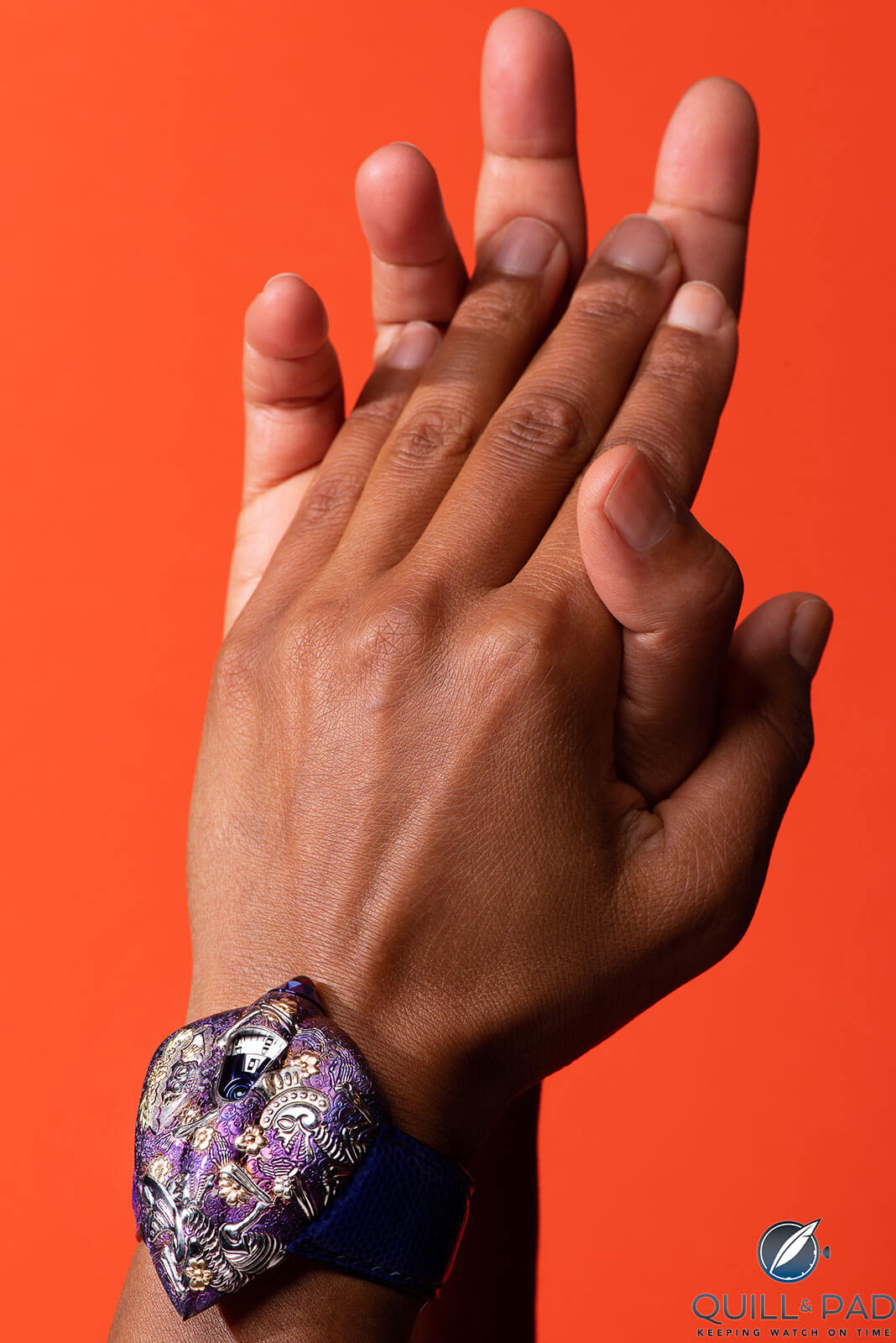
De Bethune Dream Watch 5 Maestri’Art Cempasúchil on the wrist
With its supermodel looks alone Dream Watch 5 would stand out in any crowd, but it’s no slouch in the technical department, either: jumping hours, a three-dimensional moon phase accurate to one day in 1,112 years, a silicon-and-white-gold annular balance wheel paired with a silicon escape wheel, and a five-day power reserve ensure that it is as much of a technical monster as its siblings.
De Bethune Dream Watch 5 Maestri’Art Cempasúchil: case and dial
That case. Is it an alien invention or a celestial being frozen in time and space? Hard to describe exactly what it could be, but it is exquisite. And unique. Unadorned, the case resembles a futuristic spaceship from a much more advanced species that traveled through the galaxy to reach our rocky little planet.
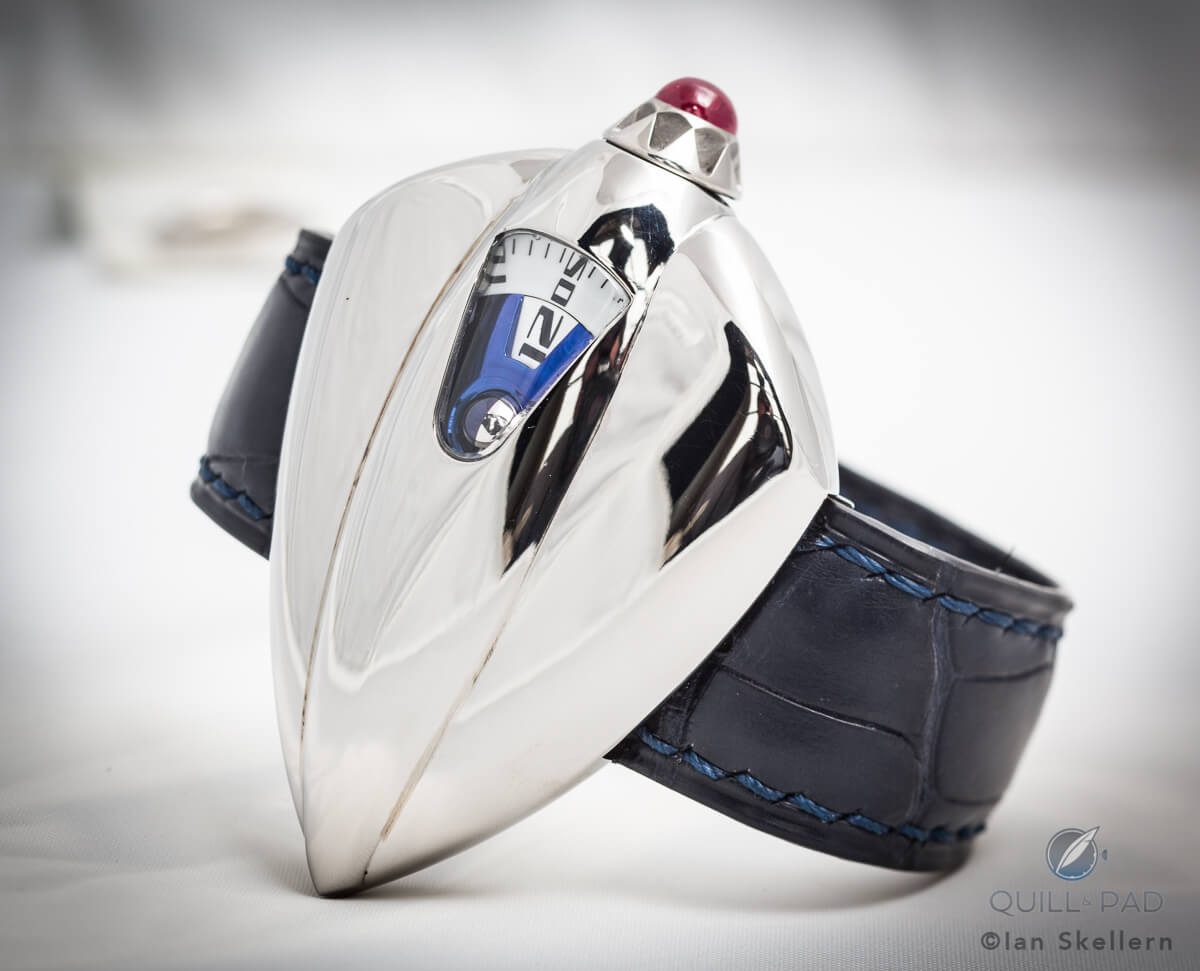
The original 2014 De Bethune Dream Watch 5 titanium case
De Bethune describes the case shape as “delta-shaped,” but I call it simply perfect. In this new Cempasúchil iteration, it is made of heat-colored grade 5 titanium and boasts 18-karat gold inserts, a variety of alloys, and a treasure trove of hand-engraving.
Even the frame of the jumping hour aperture is special in blued grade 5 titanium. It frames a curved mineral crystal that has been cut by hand and hardened to 1,800 Vickers.
And the heat-tempered titanium strap clasp is of course hand-engraved.
The meaning of Cempasúchitl or Cempasúchil
De Bethune crafted the unique Dream Watch 5 Maestri’Art Cempasúchil to honor and celebrate Mexico.
The word “cempasúchil” (also spelled cempasúchitl) originates in the original Aztec language Nahuatl and derives from the zempoalxochitl. “Zempoal” means twenty and xochitl is the word for flower. The “twenty” in this case can be interpreted as “numerous” rather than the actual number and likely refers to the petals: then entire meaning comes out to “flower of many petals.”
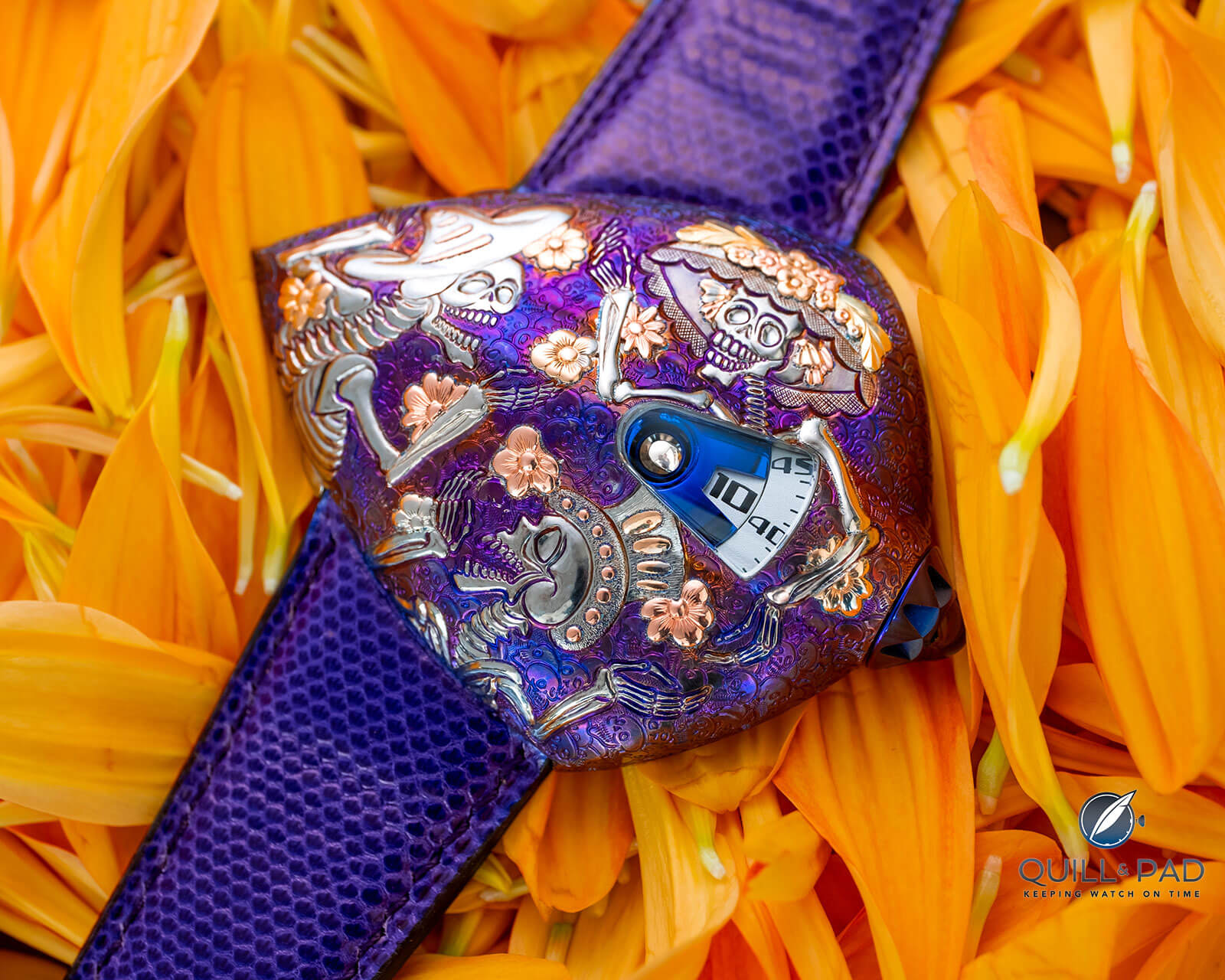
De Bethune Dream Watch 5 Maestri’Art Cempasúchil in a bed of marigold petals
At any rate, today cempasúchil is used as the common name for the Mexican marigold (tagetes erecta), which is also called the flor de muerto in Mexico – “flower of the dead” – as it figures prominently in Mexican Day of the Dead celebrations.
Marigolds bloom in Mexico at the end of the rainy season, which usually coincides with the Day of the Dead holiday celebrated between October 31 and November 2 when Mexicans remember their departed loved ones. The Day of the Dead is rooted in a belief that spirits return to the world of the living for one day in the year to be with their families (popularized through the 2017’s Pixar film Coco).
While the Day of the Dead is often thrown in with the Halloween celebrations of neighboring USA – and the root meaning has some similarities – the Mexican holiday also includes elements of the Catholic All Saints’ Day; today it has morphed to become something of a mix between its indigenous pre-Hispanic root celebration and a twentieth-century version of a Spanish Catholic tradition.
In Germany, where I live, All Saints’ Day is a national religious holiday on November 1. For me, as an ex-pat American, it is quite a convenient day off as it falls the day after Halloween (October 31), which I vigorously celebrate. But I digress.
De Bethune Dream Watch 5 Maestri’Art Cempasúchil: inspired by artists
The exquisite engraving by Swiss artisan Michèle Rothen pays homage to José Guadalupe Posada (1852-1913), a Mexican political lithographer and virtuoso with the chisel who was an expert in relief printing. He specialized in utilizing skulls, bones, and calaveras (a human skull representation that is more often than not decorative and/or edible – hence the popular term “sugar skull”) to convey his meanings.
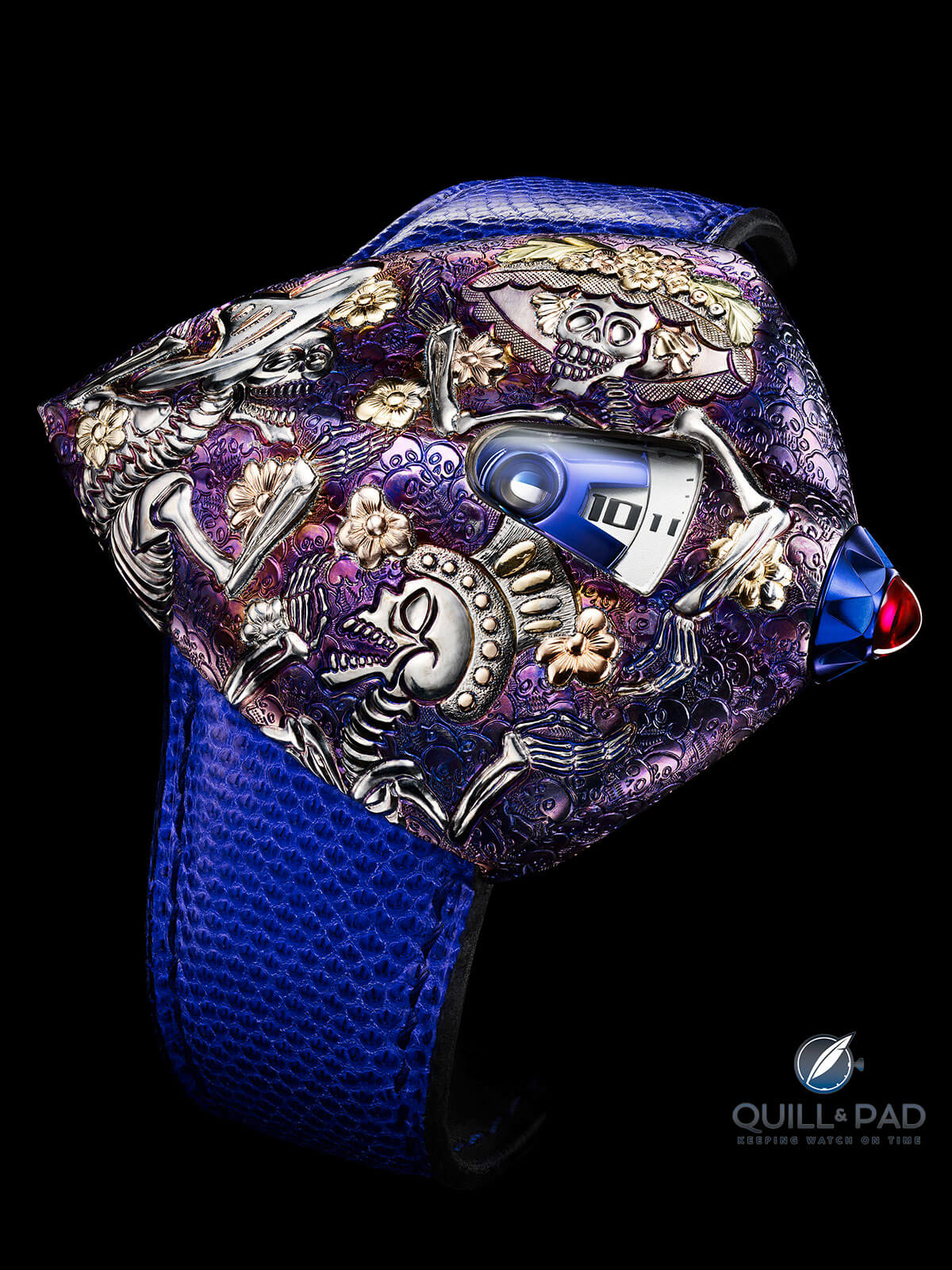
De Bethune Dream Watch 5 Maestri’Art Cempasúchil
While sugar skulls and Day of the Dead decorative elements have been popular embellishments for watches and jewelry over the last couple of years (see my roundup from Baselworld 2016 for a prime example), I can say with some confidence that very little – if any – of that was based on the idea of Posada’s work, which was also political in nature.
Though I was not directly aware of Posada’s work before laying eyes on the photos of the divine De Bethune Dream Watch 5 Maestri’Art Cempasúchil, it seems that Posada was a direct source of inspiration for one of my favorite artists, Diego Rivera, whose giant murals grace entire sections of buildings – including an entire room in the Detroit Institute of Arts’ Rivera Court consisting of 27 panels, which was the inspiration for my adolescent reverence. Not incidentally, Rivera was the on-again-off-again love of Frida Kahlo, a later discovery that made me love his work even more. But I digress again.
De Bethune Dream Watch 5 Maestri’Art Cempasúchil: technical meet artistic
It seems that De Bethune technical head Denis Flageollet, who worked with Rothen closely on the artistic look of this oeuvre, and I have much more in common that I might have thought (. . . though what am I saying? Of course we do: he has been the mastermind behind some of my favorite horological spectacles, pieces of ticking art I would give a kidney for! Oops, I’ve digressed yet again).
It goes without saying that this Dream Watch 5’s case is unique. Flageollet and Rothen miniaturized the Posada-inspired calaveras to fit on the case, at the same time providing them with more volume and relief effect than Posada’s original work would have had in his medium. The scene depicted on the case is an otherworldly scene based on the idea of a journey across the Atlantic from an old engraving by Posada.
In depicting something so new, Flageollet couldn’t let the moment pass without bringing something else new – and technical – into the mix. In this case (pun intended) it is a new technique for combining metals. Just looking at it allows you to see how challenging realizing the vision of this watch was with its tempered blue titanium, handcrafted engravings, and marigolds, calaveras, and other elements in a variety of different-colored golds.
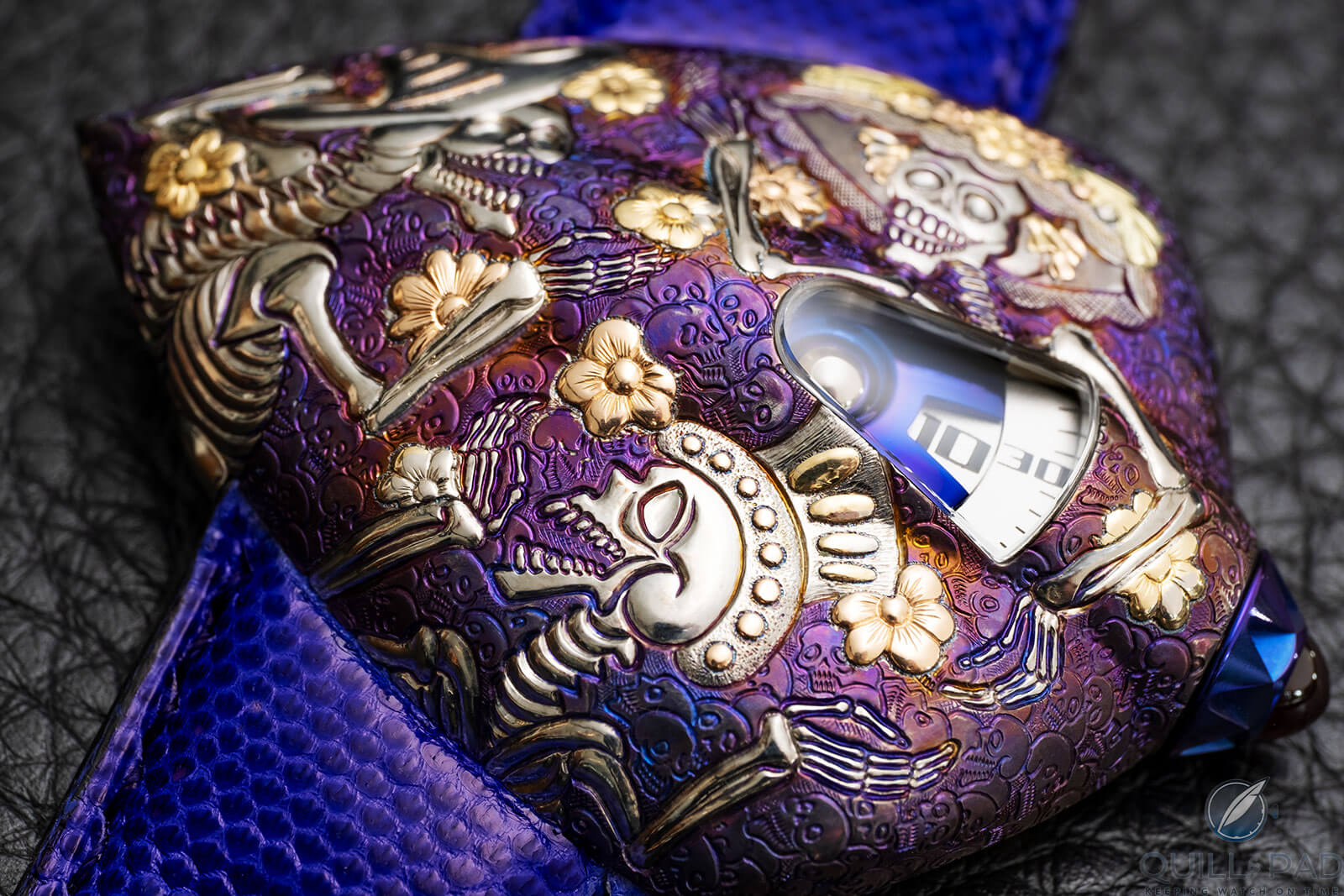
De Bethune Dream Watch 5 Maestri’Art Cempasúchil
The cempasúchil marigolds and calaveras are depicted using several types of 18-karat gold alloys: white gold, yellow gold, pink gold, green gold (which contains a smidge of silver), and a new “marbled” gold Flageollet created at De Bethune’s own foundry at its factory in Sainte Croix. Using all of these gold alloys as the celebratory flowers gifts the watch with a look like nothing else – magnificently visual with a depth in a class of its own.
And then there is the sheer difficulty of engraving titanium, which is stronger and more resistant than steel, alongside working the soft golds. This case is both a masterclass in modern metallurgy and a nod to bygone days when various different-colored gold elements adorned high-quality pocket watches.
Here’s how Flageollet achieved it: he first machined the titanium, preparing it to receive the gold inlays, working it until each piece fit perfectly – and, important to note, before any engraving commenced. Then he tempered the piece to get the titanium (but not the gold) to turn blue, which works because these two metals temper at different temperatures. Then he polished and engraved the piece together with Rothen in several steps to ensure a perfect rendition of their vision.
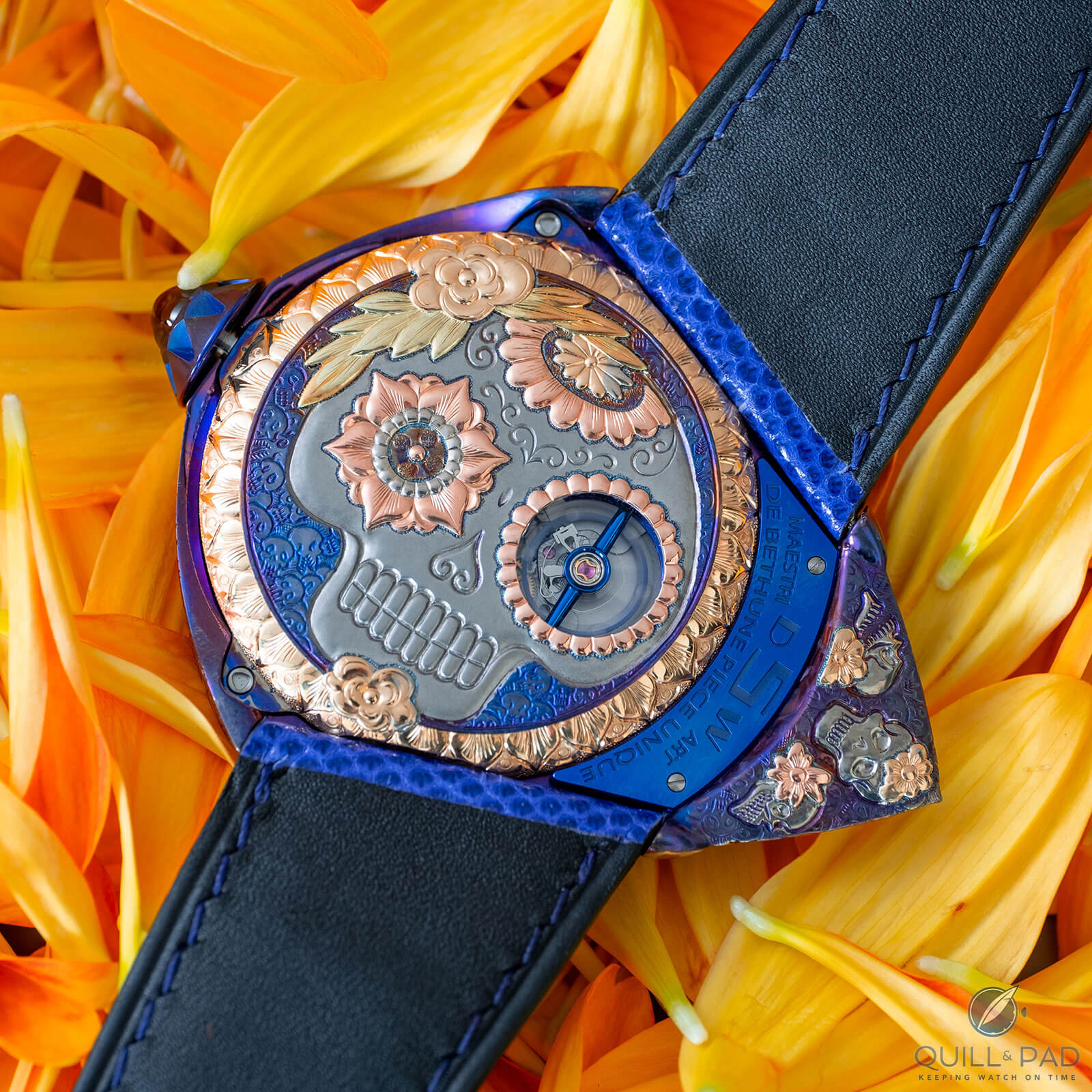
Back of the De Bethune Dream Watch 5 Maestri’Art Cempasúchil
The back of this Dream Watch 5 is very interesting as well: also crafted in titanium and 18-karat gold, it is decorated with a large calavera adorned with more flowers and petals spanning the entire case back. One of the eye sockets comprises a sapphire crystal window through which the balance spring is eminently visible.
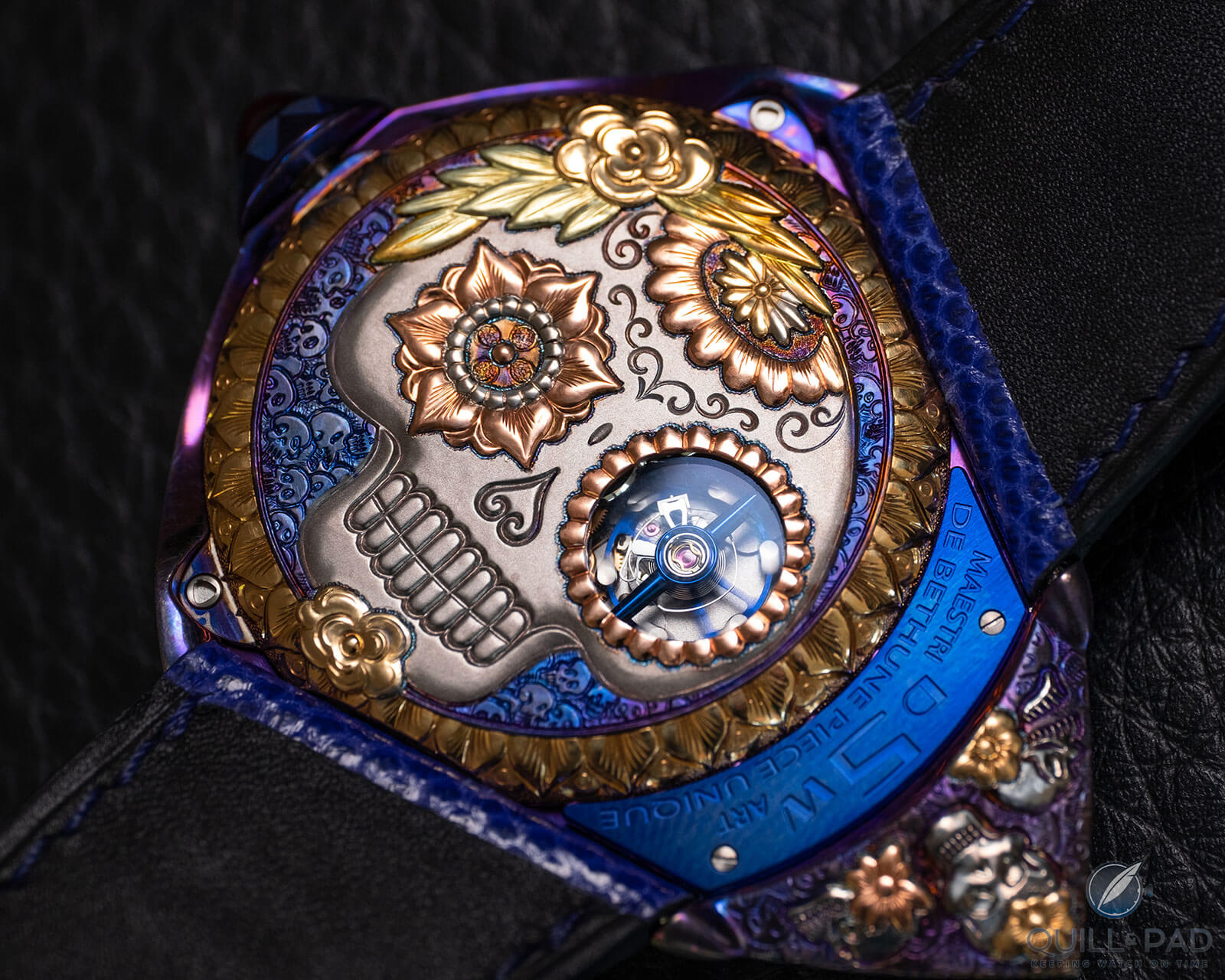
Back of the De Bethune Dream Watch 5 Maestri’Art Cempasúchil
The playful choice of making it an eye socket opening lends the grinning skull a more than mischievous look. Unfortunately, or fortunately, this grinning calavera set into a blued-titanium background of small skulls and framed by yellow gold marigold petals remains a face-down private pleasure.
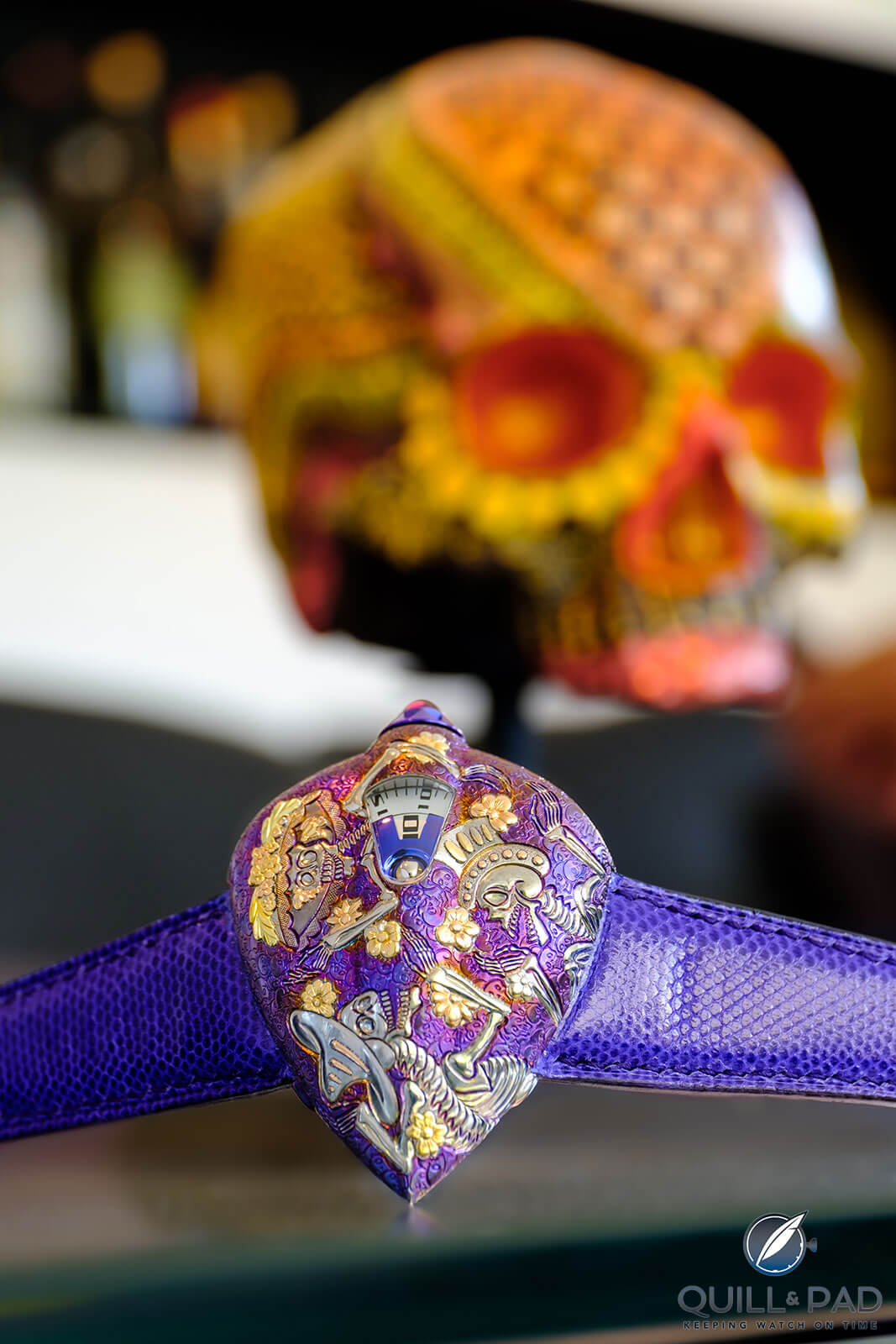
De Bethune Dream Watch 5 Maestri’Art Cempasúchil
Once more bridging technology and art, the inspired Dream Watch 5 Maestri’Art Cempasúchil is nothing short of a De Bethune dream.
For more information, please visit debethune.ch/en/media/news/de-bethune-presents-dw5-cempasuchil-one-creation-maestriart-collection.
Quick Facts De Bethune Dream Watch 5 Maestri’Art Cempasúchil
Case: 58 x 47 x 16 mm, blued titanium and gold
Movement: hand-wound Caliber DB2144V2 with silicon/white gold balance wheel, triple pare-chute shock absorber, power reserve five days, self-regulating twin spring barrels, silicon escape wheel, 4 Hz/28,800 vph frequency
Functions: jumping hours, minutes (rotating disk); spherical three-dimensional moon phase indication accurate to one day in 1,112 years
Limitation: one unique piece
Price: $305,000 / CHF 275,000
* This article was first published on December 9, 2020 at De Bethune Dream Watch 5 Maestri’Art Cempasúchil: Celebrating Mexico, Art, And The Dearly Departed.
You may also enjoy:
De Bethune DB28 Steel Wheels Sapphire Tourbillon: Let There Be (Blue) Light!
De Bethune DW5 Armilia: Science Fantasy Turned Horological Reality
De Bethune DB28 Kind Of Blue Tourbillon: The Blues Have Never Been So Joyful



Leave a Reply
Want to join the discussion?Feel free to contribute!